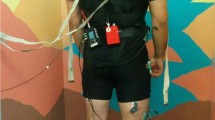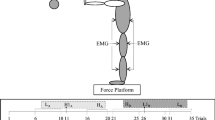Abstract
This study investigated the effects of postural set on the cortical response evoked by an external perturbation to human upright stance. Postural set was manipulated by providing either predictable or unpredictable whole body perturbations which required balance corrections to maintain upright stability. Unpredictable perturbations evoked a large negative potential (e.g., CZ: −19.9±5.1 μV) that was similar in timing (e.g., CZ: 98.9±5.5 ms) and shape to that reported in previous studies. This large negative potential was not discernable for perturbations with predictable onset timing and direction in spite of the presence of significant compensatory balance reactions. Importantly, when a surprise perturbation was presented following a series of predictable perturbations, the large negative potential occurred on this trial even though subjects expected a predictable stimulus onset. This suggests that the large negative potential was dependent on a dissociation between expected and actual stimuli rather than on a tonic central state defined by task conditions. These results suggest that cortical events may be linked to error detection that is independent of sensory or motor events associated with evoked balance reactions.




Similar content being viewed by others
References
Ackermann H, Diener HC, Dichgans J (1986) Mechanically evoked cerebral potentials and long-latency muscle responses in the evaluation of afferent and efferent long-loop pathways in humans. Neurosci Lett 66:233–238
Adkin AL, Frank JS, Carpenter MG, Peysar GW (2000) Postural control is scaled to level of postural threat. Gait Posture 12:87–93
Adkin AL, Frank JS, Carpenter MG, Peysar GW (2002) Fear of falling modifies anticipatory postural control. Exp Brain Res 143:160–170
Badke MB, Duncan PW, Di Fabio RP (1987) Influence of prior knowledge on automatic and voluntary postural adjustments in healthy and hemiplegic subjects. Phys Ther 67:1495–1500
Beckley DJ, Bloem BR, Remler MP, Roos RA, Van Dijk JG (1991) Long latency postural responses are functionally modified by cognitive set. Electroencephalogr Clin Neurophysiol 81:353–358
Beloozerova IN, Sirota MG, Swadlow HA, Orlovsky GN, Popova LB, Deliagina TG (2003) Activity of different classes of neurons of the motor cortex during postural corrections. J Neurosci 23:7844–7853
Brown JE, Frank JS (1987) Influence of event anticipation on postural actions accompanying voluntary movement. Exp Brain Res 67:645–650
Brown LA, Frank JS (1997) Postural compensations to the potential consequences of instability: kinematics. Gait Posture 6:89–97
Carpenter MG, Frank JS, Silcher CP (1999) Surface height effects on postural control: a hypothesis for a stiffness strategy for stance. J Vestib Res 9:277–286
Carpenter MG, Frank JS, Silcher CP, Peysar GW (2001) The influence of postural threat on the control of upright stance. Exp Brain Res 138:210–218
Carpenter MG, Frank JS, Adkin AL, Paton A, Allum JH (2004) Influence of postural anxiety on postural reactions to multi-directional surface rotations. J Neurophysiol 92(6):3255–3265
Dietz V, Quintern J, Berger W (1984) Cerebral evoked potentials associated with the compensatory reactions following stance and gait perturbation. Neurosci Lett 50:181–186
Dietz V, Quintern J, Berger W (1985a) Afferent control of human stance and gait: evidence for blocking of group I afferents during gait. Exp Brain Res 61:153–163
Dietz V, Quintern J, Berger W, Schenck E (1985b) Cerebral potentials and leg muscle e.m.g. responses associated with stance perturbation. Exp Brain Res 57:348–354
Dimitrov B, Gavrilenko T, Gatev P (1996) Mechanically evoked cerebral potentials to sudden ankle dorsiflexion in human subjects during standing. Neurosci Lett 208:199–202
Duckrow RB, Abu-Hasaballah K, Whipple R, Wolfson L (1999) Stance perturbation-evoked potentials in old people with poor gait and balance. Clin Neurophys 110:2026–2032
Gilles M, Wing AM, Kirker SG (1999) Lateral balance organisation in human stance in response to a random or predictable perturbation. Exp Brain Res 124:137–144
Horak FB, Diener HC, Nashner LM (1989) Influence of central set on human postural responses. J Neurophysiol 62:841–853
Maki BE, Whitelaw RS (1993) Influence of expectation and arousal on center-of-pressure responses to transient postural perturbations. J Vestib Res 3:25–39
Maki BE, McIlroy WE, Perry SD (1994) Compensatory responses to multi-directional perturbations. In: Taguchi K, Igarashi M, Mori S (eds) Vestibular and neural front: proceedings of the XIIth International Symposium on Posture and Gait, Matsumoto 3–7 May 1994. International Congress Series No. 1070. Elsevier, Amsterdam, pp 437–440
Pailing PE, Segalowitz SJ. (2004) The effects of uncertainty in error monitoring on associated ERPs. Brain Cogn 56:215–233
Perennou DA, Leblond C, Amblard B, Micallef JP, Rouget E, Pelissier J (2000) The polymodal sensory cortex is crucial for controlling lateral postural stability: evidence from stroke patients. Brain Res Bull 53:359–365
Quant S, Adkin AL, Staines WR, Maki BE, McIlroy WE (2004a) The effect of a concurrent cognitive task on cortical potentials evoked by unpredictable balance perturbations. BMC Neurosci 5:18
Quant S, Adkin AL, Staines WR, McIlroy WE (2004b) Cortical activation following a balance disturbance. Exp Brain Res 155:393–400
Solopova IA, Kazennikov OV, Deniskina NB, Levik YS, Ivanenko YP (2003) Postural instability enhances motor responses to transcranial magnetic stimulation in humans. Neurosci Lett 337:25–28
Staines WR, McIlroy WE, Brooke JD (2001) Cortical representation of whole-body movement is modulated by proprioceptive discharge in humans. Exp Brain Res 138:235–242
Wolfson L (2001) Gait and balance dysfunction: a model of the interaction of age and disease. Neuroscientist 7:178–183
Yasuda A, Sato A, Miyawaki K, Kumano H, Kuboki T (2004) Error-related negativity reflects detection of negative reward prediction error. Neuroreport 15:2561–2565
Author information
Authors and Affiliations
Corresponding author
Rights and permissions
About this article
Cite this article
Adkin, A.L., Quant, S., Maki, B.E. et al. Cortical responses associated with predictable and unpredictable compensatory balance reactions. Exp Brain Res 172, 85–93 (2006). https://doi.org/10.1007/s00221-005-0310-9
Received:
Accepted:
Published:
Issue Date:
DOI: https://doi.org/10.1007/s00221-005-0310-9




